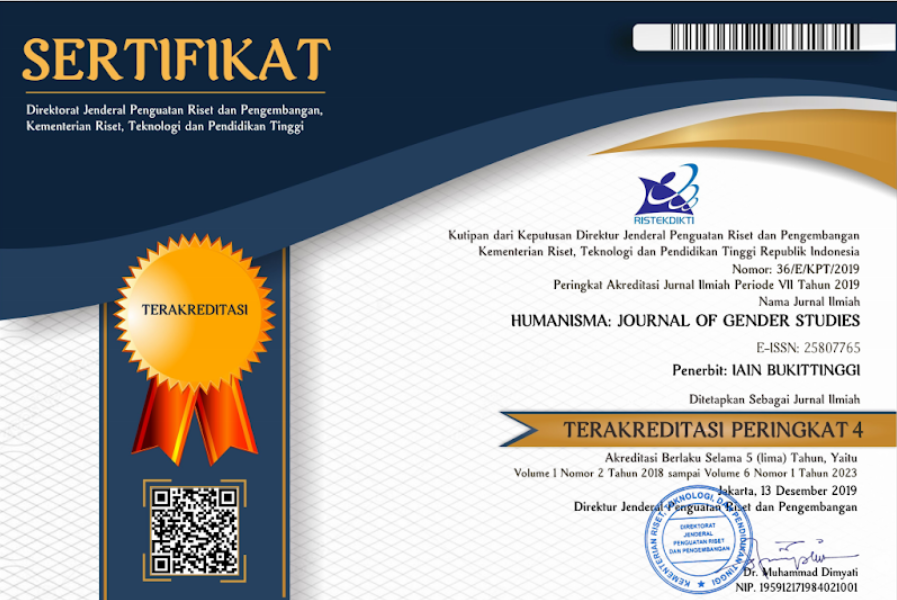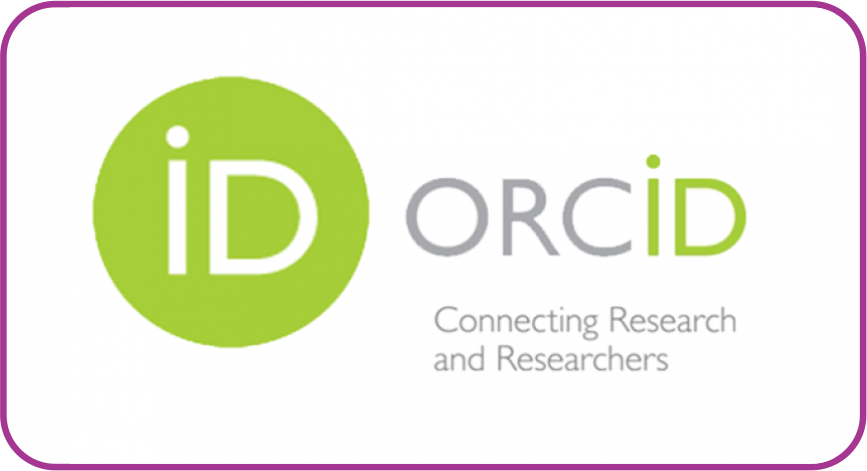Proses Pemerolehan Bahasa Arab Berperspektif Gender Sebagai Bahasa Kedua di Fakultas Tarbiyah dan Ilmu Keguruan IAIN Bukittinggi
DOI:
https://doi.org/10.30983/humanisme.v4i1.3201Keywords:
gender, language acquisition, second language acquisitionAbstract
Language has long been considered as a territory dominated by women. For example, in the area of interpretation/translation it can be seen that there are more women than men 3 to 1, and when talking about language teaching, there are more female instructors than men. So the question is: are women better at learning languages and acquiring languages than men? This research was conducted on students of the Arabic Language Study Program of IAIN Bukittinggi. Gender studies related to second language acquisition are linked to developments in two different subfields, namely: second language acquisition studies on one side and language and gender studies on the other. This research is a qualitative descriptive study and uses a performance analysis approach. The results of this study indicate that there are differences in the mastery of syntax and writing of Arabic words and letters between students and female students and there is a gender effect in acquiring and mastering Arabic as a second language.
References
Al Ghabra. Hiba, The Influence of Gender and Age in SLA, www.academia.edu/12657019/Gender_Age_and_Second_Language_Acquisition. Diakses tanggal 10 November 2019
Amin. M. Syahruddin, Perbedaaan Struktur Otak dan Perilaku Belajar Pria dan Perempuan;Eksplanasi dalam Sudut Pandang Neuro Sains dan Filsafat, Jurnal Filsafat Indonesia, Vol.1 No.1 2018.
Ansyari. M. Fauzan,Rahmi. Hasni,A Comparison between Male and Female Students’ Language Learning Strategies Preference, Indonesian Journal of Integrated English Language Teaching, Vol.2 No.1 Juni 2016
Bista, B. (2009). Age as an affective factor in second language acquisition. Retrieved in 2012, from http://www. scribd.com/doc/7753203/Age-as-an-Affective-Factor-in-Second-Language-Acquisition.
Block, D. (2002). Language & Gender and SLA. [Electronic version] Quaderns de Filologia. Estudis Linguistics, 7, 49-73.
Brown, H. D. (1987). Principles of Language Learning and Teaching. Prentice-Hall, Englewood Cliffs, N.J.
Cameron, D. (1995). Verbal Hygiene. New York: Routledge.
Collier, V. (1987). Age and rate of acquisition od second language for academic purpose. TESOL Quarterly 21:617-41.
Cummins, J. (1981b). The role of primary language development in promoting educational success for language minority students. In Schooling and language minority students: a theoretical framework, pp. 3-49. National Evaluation, Dissemination and Assessment Center, California State University.
Davis, K.A. & Skilton-Sylvester, E. (2004). Looking back, taking stock, moving forward: Investigating gender in TESOL. TESOL Quarterly 38/3, 381-404.
Ellis, R. (1985). Understanding second language acquisition. Oxford University Press.
Ellis, R. (1994). The study of second language acquisition. Oxford: Oxford University Press.
Johnstone, R. (2002). Addressing the age factor: Some implications for languages study. Stransbourg: Council of Europe.
Farhady, H. (1980) Justification, development, and validation of functional language testing. Ph.D. dissertation, University of California at Los Angeles.
Flege, J. (1987). A critical period for learning to pronounce foreign languages? Applied Linguistics 8 (2): 162-77.
Davis & Skilton. Encuentro Revista de Investigación e Innovación en la Clase de idi, 13/14, 81- 89.
Gascoigne, C. The role of gender in L2 Interaction: Socialization via L2 materials, https://dialnet.unirioja.es/servlet/articulo?codigo=2320267diakses pada tanggal 13 Februari 2020
Genesee, F. (1976). The role of intelligence in second language learning. Language Learning 26: 267-80.
Genesee, F. (1988). Neuropsychology and second language acquisition. In Beebe, L (ed.) Issues in Second Language Acquisition: Multiple Perspectives, pp. 81-112. Newbury House, Cambridge, Mass.
Hatch, E. (1983). Psycholinguistics: a second language perspective. Newbury House, Rowley, Mass.
Krashen, S. (1973). Lateralization, language learning and the critical period: some new evidence. Language Learning 23:63-74.
Krashen, S. (1979). A response to McLaughlin, 'The Monitor model: some methodological considerations'. Language Learning 29: 151-67.
Lamendella, J. (1977). General principles of neurofunctional organization and their manifestations in primary and non-primary language acquisition. Language Learning 27: 155-96.
Larsen-Freeman, D. and Long, M. H. (1991). An Introduction to Second Language Acquisition Research. Longman Inc. New York.
Lenneberge, E. (1976). Biological foundations of language. John Wiley, New York.
Morillas, M. D. P. E. (2011). An overview of the age factor and its pedagogical implications for vocabulary acquisition. Retrieved in 2012, from 4Thttp://digibug.ugr.es/bitstream4T acquisition.pdf.
Molfese, D . (1977). Theonogeny of cerebral asymmetry in man : Auditory evoked potentials to linguistic and nonlinguistic stimuli.’ In J .Desmedt (Ed.).Progress in Clinical Neurophysiology 3, Basel: Karger.
Neufeld, G. (1979). Towards a theory of language learning ability. Language Learning 29 (2): 227-41.
Oyama, S. (1976). A sensitive period in the acquisition of a non-native phonological system. Journal of Psychological Research. 5: 261-85.
Wicaksono. Andri, Subhan Reza. Ahmad, (2015), Teori Pembelajaran Bahasa, Yogyakarta: Garudhawaca.
Pristyasiwi. Paundra,Yulianto. Bambang,Efek Gender dan Tipe Kepribadian dalam Proses Pemerolehan Bahasa Jawa Sebagai Bahasa Kedua di SMK Giki 1 Surabaya, Lingua Franca: Jurnal Bahasa, Sastra, dan Pengajarannya, Vol. 2, No. 1, 2018.
Rahman. Taufiqur, (2017), Teks dalam Kajian Struktur dan Kebahasaan, Semarang: CV. Pilar Nusantara
Ratminingsih, Ni Made, Pengaruh Gender dan Kepribadian Terhadap Kompetensi Berbicara Bahasa Inggris, Jurnal Pendidikan dan Pengajaran, Jilid 46, Nomor 3, Oktober 2013
Pech, S. (1978). Child-child discourse in second language acquisition. In Hatch, E. (ed.) Second language acquisition: a book of readings, pp. 383-400. Newbury House, Rowley, Mass
Penfield, W. and Robert, L. (1959). Speech and brain mechanism. Atheneum Press, New York.
Scarcella, R. and Higa, C. (1982). Input and age differences in second language acquisition. In Krashen, S, Scarcella, R. and Long, M. (eds.) Child-adult differences in second language acquisition, pp. 175-201. Newbury House, Rowley, Mass.
Scovel, T. (1988). The recognition of foreign accents in English and its implications for of ProceedingsG and Laforge, L (eds.) -theories of language acquisition. In Savard, J psycholinguistic401. University of Laval Press, Laval. -, pp. 389Congress of AILA ththe 5
Seliger, H. (1978). Implications of a multiple critical periods hypothesis for second language learning. In Ritchie, W. (ed.) Second language acquisition research, pp. 11-19. Academic Press, New York.
Stern H. H. (1976). Optimum age: myth or reality? Canadian Modern Language Review, 32.
Snow, C. (1983). Age differences in second language acquisition: research findings and folk psychology. In Nailey, K. M., Long, M. and Peck, S. (eds.) Second language acquisition studies, pp. 141-50. Newbury House, Rowley, Mass.
Snow, C.E., & Hoefnage-Hoehle, M. (1978). The critical period for language acquisition: Evidence from second language learning. Child Development, 49, 1114-1118.
Tarigan, Henry Guntur, (2011) Pengajaran Pemerolehan Bahasa, Bandung: Angkasa
Yulianto, Bambang, (2008), Aspek Kebahasaan dan Perkembangannya, Surabaya: Unesa University Press
Downloads
Submitted
Accepted
Published
Issue
Section
License
Authors who publish with this journal agree to the following terms:
- Authors retain copyright and grant the journal right of first publication with the work simultaneously licensed under a Creative Commons Attribution-ShareAlike 4.0. that allows others to share the work with an acknowledgment of the work's authorship and initial publication in this journal.
- Authors are able to enter into separate, additional contractual arrangements for the non-exclusive distribution of the journal's published version of the work (e.g., post it to an institutional repository or publish it in a book), with an acknowledgment of its initial publication in this journal.
- Authors are permitted and encouraged to post their work online (e.g., in institutional repositories or on their website) prior to and during the submission process, as it can lead to productive exchanges, as well as earlier and greater citation of published work (See The Effect of Open Access).



















